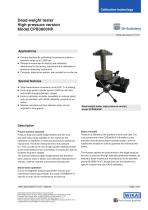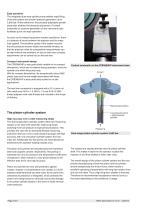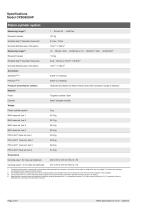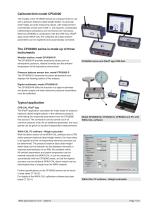
Catalog excerpts

Calibration technology WIKA data sheet CT 31.07 Dead-weight tester, high-pressure version, model CPB3800HP Applications ■ Primary standard for calibrating the pressure scale in a hydraulic range up to 2,600 bar ■ Reference instrument for factory and calibration laboratories for the testing, adjustment and calibration of pressure measuring instruments ■ Complete, stand-alone system, also suitable for on-site use Special features ■ Total measurement uncertainty up to 0.007 % of reading ■ Dual-range piston-cylinder system 2,600 bar with fully automated changing between ranges ■ Factory calibration includes traceability to national standards, as standard, with UKAS calibration possible as an option ■ Masses manufactured from stainless steel, can be adjusted to local gravity Description Proven primary standard Pressure balances (dead-weight testers) are the most accurate instruments available on the market for the calibration of electronic or mechanical pressure measuring instruments. The direct measurement of the pressure (p = F/A), as well as the use of high-quality materials enable a very small measurement uncertainty, in conjunction with an excellent long-term stability. The pressure balance (dead-weight tester) has therefore been used for years in factory and calibration laboratories in industry, national institutes and research laboratories. Stand-alone operation Due to its integrated pressure generation and the pure mechanical measuring principle, the model CPB3800HP is ideal for on-site use for maintenance and service. Basic principle Pressure is defined as the quotient of force and area. The core component of the CPB3800HP is therefore a very precisely manufactured piston-cylinder system, which is loaded with masses in order to generate the individual test points. The masses applied are proportional to the target pressure and this is achieved through optimally graduated masses. As standard, these masses are manufactured to the standard gravity (9.80665 m/s2), though they can be adjusted to a specific location and also UKAS calibrated. IwikaII ^ Part of your business WIKA data sheet CT 31.07 • 02/2015 Data sheets showing similar products and accessories: Dead-weight tester in compact design; model CPB3800; see data sheet CT 31.06 Pneumatic dead-weight tester; model CPB3500; see data sheet CT 31.22 Hydraulic pressure balance; model CPB5800; see data sheet CT 31.11 Pressure balance in high-pressure version; model CPB5000HP; see data sheet CT 31.51 CalibratorUnit; model CPU6000; see data sheet CT 35.02
Open the catalog to page 1
Easy operation The integrated dual-area spindle pump enables rapid filling of the test system and smooth pressure generation up to 2,600 bar. At the same time, the precisely adjustable spindle pump also enables fine pressure adjustment. A control schematic for pressure generation on the instrument base facilitates quick and easy operation. As soon as the measuring system reaches equilibrium, there is a balance of forces between the pressure and the mass load applied. The excellent quality of the system ensures that this pressure remains stable over several minutes, so that the pressure...
Open the catalog to page 2
The following tables show, for the respective measuring The masses are manufactured, as standard, to the standard range, the number of masses within a mass set, with their gravity (9.80665 m/s2) although they can be adjusted for any resulting nominal pressures. particular location. The relevant corrections should be made for example with the CPU6000 CalibratorUnit, see page 7, to ensure that the measuring system remains within specification (ambient temperature 20 °C, atmospheric pressure 1,013 mbar, relative humidity 40 %). q ti. Nominal pressure per piece Nominal pressure per...
Open the catalog to page 3
1) Theoretical starting value; corresponds to the pressure value generated by the piston or the piston and its make-up weights (by their own weight). To optimise the operating characteristics more masses should be loaded. 2) The smallest pressure change value that can be achieved based on the standard mass set. To reduce this, a set of fine increment masses is also available. 3) The accuracy from 10 % of the measuring range is based on the measured value. In the lower part the accuracy is 0.025 % of reading. 4) Measurement uncertainty assuming reference conditions (ambient temperature 20...
Open the catalog to page 4
Dimensions in mm (without masses) 1 Piston connection Test item connection Dual-area spindle pump with star handle Rotatable feet High-pressure shut-off valve Reservoir with plug screw Low-pressure shut-off valve Pressure generation control schematic Standard connection piston-cylinder system Test item connection Adapter, see scope of delivery WIKA data sheet CT 31.07 ∙ 02/201
Open the catalog to page 6
CalibratorUnit model CPU6000 The models of the CPU6000 series are compact tools for use with a pressure balance (dead-weight tester). In particular when highly accurate measuring values, with measurement uncertainties of less than 0.025 %, are required, complicated mathematical calculations and corrections are necessary. With the CPU6000 in combination with the CPB-CAL (iPad® app) and/or WIKA-CAL (PC software) all critical ambient parameters can be registered and automatically corrected. The CPU6000 series is made up of three instruments Weather station, model CPU6000-W The CPU6000-W...
Open the catalog to page 7
Dead-weight tester, model CPB3800 Measuring ranges: Hydraulic 1 ... 120 up to 10 ... 1,200 bar or 0.025 % of reading (optional) For specifications see data sheet CT 31.06 Dead-weight tester, model CPB3800 Dead-weight tester, model CPB3500 Measuring ranges: Pneumatic -0.015 ... -1 to 1 ... 120 bar or 1 ... 100 to 10 ... 1.600 psi, respectively Accuracy: 0.015 % of reading up to 0.006 % of reading (optional) For specifications see data sheet CT 31.22 Dead-weight tester, model CPB3500 Pressure balance, model CPB5800 Measuring ranges: Hydraulic Single-piston measuring ranges: up to...
Open the catalog to page 8
Mass sets Set of trim masses M1 and F1 The masses included in the standard mass set are ideally suited for everyday use. If smaller intermediate values need to be generated, we recommend using a set of class M1 or F1 trim masses, with the following masses: 1 x 50 g, 2 x 20 g, 1 x 10 g, 1 x 5 g, 2 x 2 g, 1 x 1 g, 1 x 500 mg, 2 x 200 mg, 1 x 100 mg, 1 x 50 mg, 2 x 20 mg, 1 x 10 mg, 1 x 5 mg, 2 x 2 mg, 1 x 1 mg Scope of delivery ■■ Base Accessories Adapter ■■ Dual-area spindle pump for filling, pressure generation ■■ Adapter for connection column, M16 x 1.5 male thread ■■ Adapter for...
Open the catalog to page 9All Mensor catalogs and technical brochures
-
Mensor Sensors
2 Pages
-
WIKA Handbook
436 Pages
-
Calibration
20 Pages
-
Handbook Calibration
73 Pages
-
Condensed Custom Systems
4 Pages
-
Custom Systems
20 Pages
-
Calibration Technology
32 Pages
-
Model CPB5000
12 Pages
-
Model CPB3800
15 Pages
-
Model CPB3500
9 Pages
-
Model CTP5000
6 Pages
-
Models CTP2000, CTP9000
4 Pages
-
Model WIKA-Cal
6 Pages
-
Model CPA8001
8 Pages
-
Model CPC8000-H
7 Pages
-
Model CPC8000
8 Pages
-
MODEL CPC7000
9 Pages
-
Model CPC6050
8 Pages
-
Model CPC4000
8 Pages
-
Model CPC2000
6 Pages
-
Model CPG500
6 Pages
-
Model CPG-KITH
6 Pages
-
Model CPG-KITP
6 Pages
-
Model CPG1500
11 Pages
-
CPG2300
2 Pages
-
CPG2400 Barometer
2 Pages
-
CPA8001
8 Pages
-
CPA2501
8 Pages
-
CPC8000
8 Pages

































